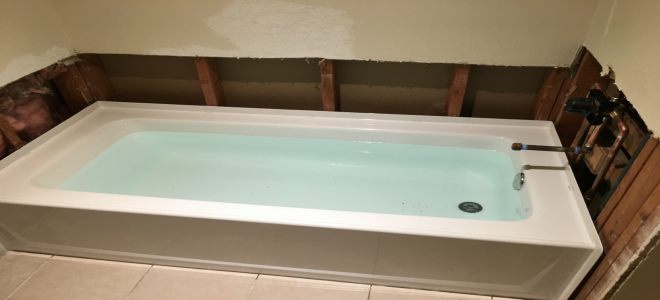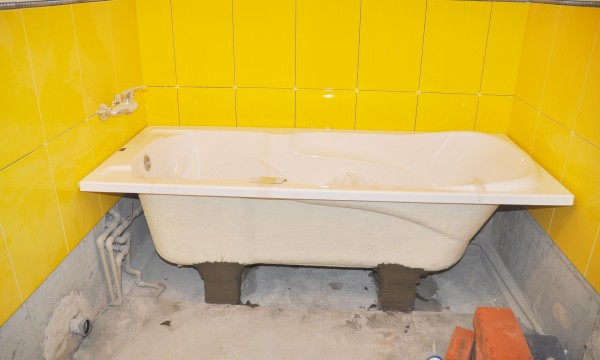On this page down the page you might get lots of reliable help and advice all about A Step-by-Step Guide to Installing a Bathtub.

Installing a tub isn't specifically rocket science, yet it does require strong plumbing, carpentry, as well as often, tiling abilities. Replacing an old bathtub with a brand-new one is likewise a reasonably challenging task. If the old tub is conveniently available, the task can move speedily; if you have to open up a wall to get rid of the old tub as well as position the new bath tub, the task is a lot harder. In either case, the task is within a house handyman's skills, although you will certainly require a helper to move out the old bathtub and set in the brand-new one. Ensure you have actually qualified yourself for the work and fit trying it. Instead of working with a professional to take control of a halfway-completed project, it is much better to take into consideration employing one before you start. Opportunities are you may require an expert plumber to make tube links.
This article will certainly aid you install a new bath tub in your bathroom if you have actually currently purchased a brand-new bathtub and don't require to transform the arrangement of your previous supply of water pipelines.
Your devices and material checklist must consist of the following:
Removing Old Taps
If you need to change old faucets with new ones as a part of your setup, after that the first thing you should do is detach the water. After doing so, turn on the taps to drain pipes any kind of water remaining in the system. The process of getting rid of the existing faucets can be quite troublesome because of the limited access that is typically the situation.
Make use of a basin wrench (crowsfoot spanner) or a faucet device to undo the nut that attaches the supply pipes to the taps. Have a fabric prepared for the continuing to be water that will come from the pipes. When the supply pipelines have actually been gotten rid of, use the same tool to loosen the nut that holds the faucets onto the bath/basin. You will certainly require to quit the solitary taps from turning during this process. When the taps have been eliminated, the holes in the bath/basin will have to be cleaned up of any type of old securing substance.
Prior to going on to fit the brand-new faucets, contrast the pipeline links on the old faucets to the brand-new faucets. If the old faucets are longer than the brand-new faucets, after that a shank adapter is needed for the brand-new faucets to fit.
Suitable New Touches
If the tails of the brand-new faucets are plastic, after that you will need a plastic port to avoid damages to the string. One end of the adapter fits on the plastic tail of the faucet and also the various other end gives a link to the current supply pipelines.
If you require to fit a monobloc, after that you will require reducing couplers, which attaches the 10mm pipeline of the monobloc to the typical 15mm supply pipeline.
Next off, place the faucet in the installing hole in the bath/basin guaranteeing that the washers are in place between the faucet and also the sink. Safeguard the faucet in place with the producer given backnut. As soon as the faucet is safely in place, the supply pipes can be connected to the tails of the faucets. The faucets can either be linked by using corrugated copper piping or with normal tap adapters. The previous type ought to be connected to the faucet finishes first, tightening just by hand. The supply pipelines can later be attached to the various other end. Tighten both ends with a spanner after both ends have been attached.
Mounting the Tub
Using both wooden boards under its feet, place the bath tub in the needed position. The wooden boards are handy in equally spreading out the weight of the bathtub over the location of the boards as opposed to focusing all the weight onto four tiny points.
The next objective is to ensure that the bath tub is leveled all round. This can be accomplished by checking the spirit level and readjusting the feet on the tub until the level checks out level.
To set up taps, fit all-time low of the outermost flexible faucet port to the ideal supply pipe by making a compression sign up with; then do the same for the various other tap.
Switch on the water as well as check all joints and also brand-new pipework for leakages as well as tighten them if required. Fill the bath tub as well as likewise check the overflow electrical outlet as well as the normal electrical outlet for leaks.
Finally, deal with the bath paneling as defined in the maker's instruction manual. Tiling and also sealing around the bath tub must wait until the bathtub has actually been utilized at least when as this will resolve it into its last setting.
Preparing for the Installment
First of all, the supporting structure supplied with the bath must be fitted (if needed) according to the manufacturer's guidelines. Next, fit the faucets or mixer to the tub. When fitting the faucet block, it is essential to see to it that if the tap comes with a plastic washing machine, it is fitted between the bathroom as well as the faucets. On a plastic bathroom, it is also reasonable to fit a supporting plate under the taps device to avoid stress on the bath tub.
Fit the versatile faucet ports to the bottom of the two faucets using 2 nuts as well as olives (sometimes provided with the tub). Fit the plug-hole electrical outlet by smearing mastic filler round the sink outlet opening, and then pass the electrical outlet through the hole in the bathroom. Use the nut supplied by the supplier to fit the plug-hole. Take a look at the plug-hole electrical outlet for an inlet on the side for the overflow pipe.
Next off, fit the end of the versatile overflow pipeline to the overflow electrical outlet. After that, screw the pipeline to the overflow face which should be fitted inside the bath. Make certain you make use of all of the supplied washing machines.
Attach the trap to the bottom of the waste outlet on the tub by winding the string of the waste outlet with silicone mastic or PTFE tape, as well as screw on the catch to the electrical outlet. Connect the bottom of the overflow tube in a similar manner.The bathroom need to now be ready to be fitted in its final position.
Tiling Around the Tub
In the location where the bathroom meets the ceramic tile, it is needed to seal the joins with a silicone rubber caulking. This is essential as the installation can relocate sufficient to crack a rigid seal, triggering the water to permeate the wall surface in between the bathroom and also the tiling, leading to complications with dampness and possible leaks to the ceiling below.
You can pick from a selection of coloured sealants to blend in your fixtures as well as installations. They are sold in tubes as well as cartridges, and also are capable of sealing spaces up to a width of 3mm (1/8 inch). If you have a larger space to load, you can load it with spins of soaked newspaper or soft rope. Keep in mind to always fill up the bath tub with water before securing, to permit the activity experienced when the bathtub remains in use. The sealant can break relatively early if you do not take into consideration this motion prior to securing.
Additionally, ceramic coving or quadrant tiles can be utilized to edge the bathroom or shower tray. Plastic strips of coving, which are easy to use and also reduce to dimension, are additionally conveniently readily available on the marketplace. It is advisable to fit the floor tiles making use of waterproof or water-proof glue and also cement.
Bathtub Installation
How Important Is A Bathtub To Your Home?
High-quality baths, showers, and other bathroom updates are necessary when considering a smart investment in your home. It’s a room that you go to every day and one that is constantly being used by guests.The bathroom is one of the top trafficked rooms in a home and also one of the most valuable in terms of home resale.
Install Piping Before Tub
You will be using your existing drain and waste vent system, but pipes required include the hot and cold water supply lines and a pipe leading to a shower head. A mixing valve and shower head are also needed. Air chambers may be required.
Position the Tub
Lower the tub into place so that the continuous flange fits against the wall studs and rests on 1’x4' or 2’x4' supports. Anchor the tub to the enclosure with nails or screws inserted through the flanges into the studs.
NOTE: Remember, bathtubs and shower stalls may require support framing. A bathtub filled with water is extremely heavy, so check building codes and framing support before installing the tub.
Assemble Drain Connections
Assemble the bathtub drain connections by connecting the tub overflow with the tub drain above the trap, not beyond it. The trap will have a compression fitting that screws over the arm of the overflow assembly.
Place a Pipe For the Shower Head
First, locate a brass female threaded winged fitting and attach it to a framing support via a screw or a nail. Then run a pipe up the wall for the shower head. Sweat or solder the other side of the brass fitting to the top of the pipe.
Attaching Hot and Cold Water Lines
Attach your water lines for both hot and cold by sweating these directly into the hot and cold ports of the mixing valve. The mixing valve will be how water enters the tub’s system, not by the pipes themselves.
Install the Spout
Extend a piece of 1/2 inch pipe, or whichever length is specified in the manufacturer’s instructions, for the tub spout. Sweat on a male threaded fitting at the end of the pipe or use a brass nipple of the proper length and a 1/2 inch cap.
NOTE: At this point you should have your rough-in plumbing work inspected before proceeding further.
Check For Leaks
Restore the water pressure and check the drain connection and the supply pipes for any sign of leaking.
estore the Bathroom Wall
Replace the wall with moisture-resistant drywall as a base for your wall covering. Seal the joints between the wall and your new tub with silicone caulk as protection against water seepage.
https://www.berkeys.com/2016/12/02/bathtub-installation-dallas/

Do you appreciate more info about How to Install a Bathtub? Write a remark down the page. We would be interested to hear your views about this review. Hoping to see you back again in the future. If you enjoyed reading our blog entry plz do not forget to pass it around. Thank-you for taking the time to read it.
Visit The Following Page